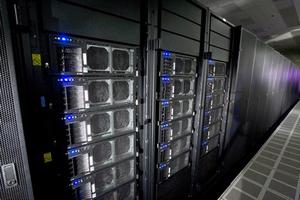National labsLos Alamos National Lab: Deploying 100 supercomputers over 60 years in support of national security
From the 1952 MANIAC to Bonanza deployed just this month, Los Alamos National Laboratory has deployed 100 supercomputers in the last sixty years — a showcase of high-performance computing history. The Los Alamos computers deployed along the way include the MANIAC II, which started its nearly 20-year service life with over 5,000 vacuum tubes, all of which were replaced over time with circuit boards. Other deployed systems include Stretch, a technological stretch built in collaboration between Los Alamos and IBM, Serial Number 1 of the iconic Cray-1, and a Thinking Machines CM-5, with its lightning bolt footprint and fat-tree interconnect. By 2008 there came Roadrunner, the world’s first petaflop supercomputer.

An IBM Roadrunner supercomputer in operation // Source: wikipedia.org
From the 1952 MANIAC to Bonanza deployed just this month, Los Alamos National Laboratory has deployed 100 supercomputers in the last sixty years — a showcase of high-performance computing history.
“The computing capability in our data centers in any given year dwarfs what was there ten years before,” said Randal Rheinheimer of the High Performance Computing division, “and Los Alamos has been on that curve for sixty years.”
The Los Alamos computers deployed along the way include the MANIAC II, which started its nearly 20-year service life with over 5,000 vacuum tubes, all of which were replaced over time with circuit boards. An LANL release reports that any computing device today would have to be purpose-built to compute as slowly as the MANIAC computers. Compared to a room full of people with mechanical calculators, however, those early computing tools were significant advances, Rheinheimer notes. “It was the first and only triumph of serial over parallel computing.”
Other deployed systems include Stretch, a technological stretch built in collaboration between Los Alamos and IBM, Serial Number 1 of the iconic Cray-1, and a Thinking Machines CM-5, with its lightning bolt footprint and fat-tree interconnect. “The fat-tree today seems an obvious topology, but we have detailed diagrams of it in our archive labeled ‘Thinking Machines Proprietary’,” says Rheinheimer.
By 2008 there came Roadrunner, the world’s first petaflop supercomputer, which provided a boost for unclassified science before being moved to the secure side to perform feats of computational heavy lifting for the nuclear stockpile stewardship program. A mere five years after installation, its powers were eclipsed by the next generation of big iron and its components were repurposed.
“Computing power for our Laboratory’s national security mission is a huge part of our proud legacy, and it plays an integral role in our bold future,” says Laboratory director Charlie McMillan. “The continued innovation and enhancement of this capability touches areas from stockpile stewardship, to global security simulation, to biological modeling, and even safety basis calculations. I look forward to our next 100 supercomputers and their impact on the nation.”
These days, the Lab has thirteen supercomputers, or “high performance computing clusters,” operating in both unclassified and classified environments. With names like Cielo, Lobo, Mustang and Moonlight, the work performed by Roadrunner has been shifted to other machines.
Cielo, a current stalwart of National Nuclear Security Administration (NNSA) capability computing, has a time-lapse video of its installation posted on YouTube.
The release notes that the computer review overall is part of Los Alamos’ burgeoning HPC History Project, in partnership with the Charles Babbage Institute at the University of Minnesota. As part of the effort, a new infographic has been produced, illustrating a few highlights in the deployment of the first one hundred systems.
The project has been unearthing a wealth of information about supercomputers and the supercomputing industry, as viewed through the prism of seventy years of computing for science in the national interest at Los Alamos National Laboratory.
